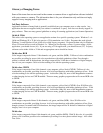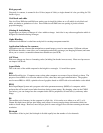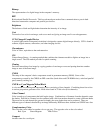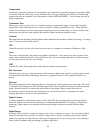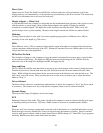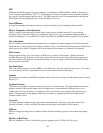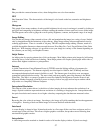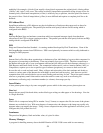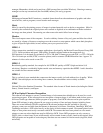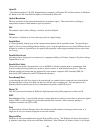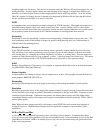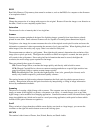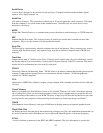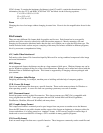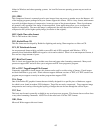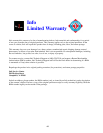59
manager, Memmaker, which can be run from a DOS-prompt (but not within Windows). Running a memory
manager can free up conventional (the first 640K) memory for use by programs.
MIME
Multipurpose Internet Mail Extensions, a standard format that allows the attachment of graphics and other
non-text files, such as programs, to text-based e-mail messages.
Moiré
Moiré is caused by the printing process of images in printed materials such as books or magazines. Moiré is
caused by the resolution the original picture was scanned or digitized at in combination with the resolution
the image was then printed. Descreening can often remove the moiré effect from an image.
Monitor
The visual output screen of the computer. It works with tiny clusters of tiny red, green and blue dots which
are struck by a beam of electrons sweeping across the screen in a raster pattern which causes their phosphors
to give off specific light which, in turn, reaches your eye as perceived color.
MPEG-1
Video compression standard for consumer applications, developed by the Motion Picture Experts Group (ISO
11172). Good resolution and speed, VHS quality. Normally requires hardware decompression (e.g.
ELSAmotion). It is designed for resolutions of 352 x 288 with 25 frames per second (PAL), or 352 x 240 with
30 or 24 frames per second (NTSC or motion picture) and for common CD-ROM transfer rates. Approx. 70
minutes of video can be saved on one CD.
MPEG-2
Broadcasting quality standard, for example for full CCIR 601 quality or HDTV (high-resolution 16:9
television). Requires considerably higher transfer rates and memory capacities than MPEG-1 and is therefore
not suitable for the consumer market.
MPEG-3
This is a relatively new standard that compresses the image or audio (or both) without loss of quality. While
MPEG-3 decoders/players are becoming more common, encoders/editors are not widely available.
NTSC
National Television Standard Committee. The standard video format of North America (including the United
States), Central America, and Japan.
OCR or Optical Character Recognition
The software will attempt to convert a scanned image of a document into editable text to be used in a word-
processing program. If the software does not recognize a character shape, it will either make its best guess or
will insert a null type character (differs program to program). Good OCR software can be quite expensive.
Some OCR software is quite advanced & can convert a variety of fonts and page formats, including forms.
There are several different TWAIN-compliant OCR software packages that are available as 3rd-party
software, some even available from the Internet as shareware or freeware: Cuneiform, OmniPage, WOCAR,
TextBridge and others. OCR relies heavily on the clarity of the document scanned. Documents printed on an
inkjet or laser printer most easily converted with OCR. Documents that have been printed on a dot matrix
printer or come are carbon duplicates may be difficult to OCR. Some OCR programs can only convert to
ASCII, plain, or other forms of text, which usually will not retain format or fonts, found in the original. Most
OCR programs are incapable of converting any item that was not scanned in LineArt mode (single bit, black
and white).



